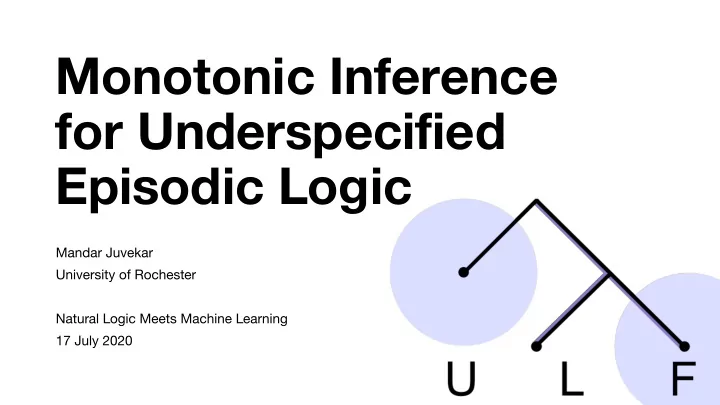

Monotonic Inference for Underspecified Episodic Logic Mandar Juvekar University of Rochester Natural Logic Meets Machine Learning 17 July 2020
Gene Louis Kim Lenhart K. Schubert UR UR
Sánchez Valencia Lambek Derivations Tableau-style proofs “abelard sees a carp” “abelard sees a fish” “every carp is a fish” Replace Lambek derivations and sentences with ULFs (|Abelard| (see.v (a.d fish.n))) (|Abelard| (see.v (a.d carp.n))) ULF
Episodic Logic (EL) An extended FOL that closely matches the form and expressivity of natural language. Unscoped Logical Form (ULF) An underspecified form of EL. Specifies semantic type structure while leaving scope, anaphora, and word sense unresolved.
(|Adam| ((past place.v) |John| (under.p (k arrest.n)))) “Adam placed John under arrest.”
Typical EL Inference Unscoped episodic logical forms are fully resolved before inference
Premises Interpret Infer Conclude
Key Observation ULF provides the structural foundation for monotonic inference
(|Ali| (do.aux-s not (know.v (that (i.pro (work.v (adv-a (with.p (a.d dog.n))))))))) “Ali does not know that I work with a dog”
Preserved Word Order (|Ali| (do.aux-s not (know.v (that (i.pro (work.v (adv-a (with.p (a.d dog.n))))))))) “Ali does not know that I work with a dog”
Grammatical Structure (|Ali| (do.aux-s not (know.v (that (i.pro (work.v (adv-a (with.p (a.d dog.n))))))))) “Ali does not know that I work with a dog”
Semantic Types (|Ali| (do.aux-s not (know.v (that (i.pro (work.v (adv-a (with.p (a.d dog.n))))))))) e ⟨ t’,t’ ⟩ ⟨⟨ e,t’ ⟩ ,e ⟩ ⟨ e, ⟨ e,t’ ⟩⟩ ⟨⟨ e,t’ ⟩ ,e ⟩ ⟨ e,t’ ⟩ ⟨ t’,t’ ⟩ ⟨ e, ⟨ e,t’ ⟩⟩ ⟨ t’,e ⟩ e ⟨ e, ⟨ e,t’ ⟩⟩ “Ali does not know that I work with a dog”
We need semantic argument structure “Some man holds no apple” Some: (+,+) No: (-,-)
We need semantic argument structure “Some man holds no apple” Some: (+,+) No: (-,-) Some man touches no apple Grammatical ((Some man) (holds (no apple))) Some man holds no apple
We need semantic argument structure “Some man holds no apple” Some: (+,+) No: (-,-) Some man touches no apple Grammatical ((Some man) (holds (no apple))) Some man holds no apple (Some x: (x man) (no y: (y apple) Semantic (x holds y))) Some man clenches no apple
Proposal Directly use ULFs as the basis for inference
Scope Marking Sánchez Valencia Label
Scope Marking Sánchez Valencia ULF Label
Polarity Marking Sánchez Valencia
Polarity Marking Sánchez Valencia ULF
Inference Rules
Inference Rules
Inference Rules
Inference Rules
Inference Rules
Inference Rules
Generalized Inference Rule Instantiation (EL) “Every carp is a fish” “Abelard sees a carp”
Generalized Inference Rule Instantiation (EL) “Every carp is a fish” 1. Select logical fragments with opposing polarities “Abelard sees a carp”
Generalized Inference Rule Instantiation (EL) “Every carp is a fish” 1. Select logical fragments with opposing polarities “Abelard sees a carp” (x → y) 2. Matchably bind the two fragments (fail if unable)
Generalized Inference Rule Instantiation (EL) “Every carp is a fish” 1. Select logical fragments with opposing polarities “Abelard sees a carp” (x → y) 2. Matchably bind the two fragments (fail if unable) (y carp.n) → T 3. Convert the formula with the negative polarity fragment
Generalized Inference Rule Instantiation (EL) “Every carp is a fish” 1. Select logical fragments with opposing polarities “Abelard sees a carp” (x → y) 2. Matchably bind the two fragments (fail if unable) (y carp.n) → T 3. Convert the formula with the negative polarity = fragment
Generalized Inference Rule Instantiation (EL) 1. Select logical fragments with opposing polarities 2. Matchably bind the two fragments (fail if unable) 3. Convert the formula with the negative polarity fragment
Generalized Inference Rule Instantiation (EL) 1. Select logical fragments with opposing polarities 2. Matchably bind the two fragments (fail if unable) 3. Convert the formula with the negative polarity fragment 4. Substitute converted formula for other match “Abelard sees a fish”
Generalized Inference Rule Instantiation (EL) MAJ: 1. Select logical fragments with opposing polarities MIN : 2. Matchably bind the two fragments (fail if unable) 3. Convert the formula with the negative polarity fragment 4. Substitute converted formula for other match “Abelard sees a fish”
Generalized Inference Rule Instantiation (EL) ULF Monotonic Inference generalizes
Benefits ● Reduce sources of parsing error ● Dynamically choose scoping assumptions ● Retain a record of assumptions and inferences ● Simple interface to surface form
Integration with ML ● ULF was designed for ease of ML-based parsing. Parser under review with similar performance to initial AMR parsers ● ML-assisted ambiguity resolution (e.g. scopes, word sense, polarity) ● Retain semantic type and polarity coherence for interpretable inferences.
Thanks!
Recommend
More recommend